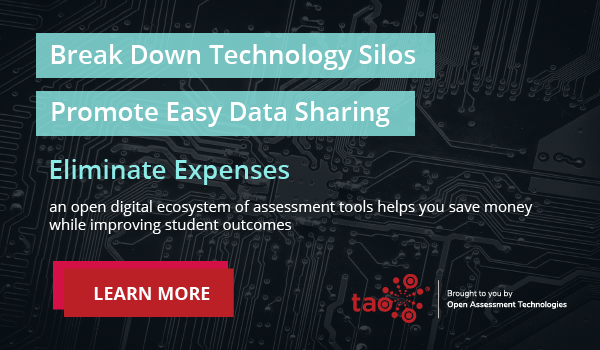Critical thinking skills are some of the most highly sought-after skills in the business world and with good reason. Individuals with critical thinking skills can take in data and information and analyze it quickly to make informed decisions on the spot. Critical thinkers are also excellent problem solvers who may come up with innovative and new solutions to problems that arise in the workplace and their personal lives. These thinkers also can communicate these nuanced ideas to their colleagues effectively and efficiently. In short, the world needs more critical thinkers equipped with skills to solve problems in the modern world.
Schools play a vital role in developing critical thinking skills for the 21st century and a large part of fostering those skills includes assessment. Assessing critical thinking means going deeper than traditional multiple-choice or true/false testing. A critical thinking assessment requires students to look at data, develop unique solutions to problems, and express their thinking to the world. In today’s world, critical thinking may leverage tools such as artificial intelligence to leverage analytics to describe an event using data, explain why it happened, make decisions, and make predictions.
Artificial Intelligence and Critical Thinking Assessment
In education, artificial intelligence is proving to be a controversial tool with many teachers embracing it for test creation and automatic tasks while also having concerns over student use or generative AI in the classroom. However, AI is not going away any time soon, and AI tools may give students a leg up in engaging in topics at a deeper level.
Instead of seeing AI as the enemy, many teachers are using AI to give students the ability to cut through tedious menial work to get at the heart of thinking. By teaching students to use AI as a tool to enhance critical thinking students can develop deeper thoughts and use the information afforded by computer technology to think critically.
How to Make this Future a Reality?
In an interview with critical thinking expert and founder of Macat International, a company that specializes in critical thinking solutions, Salah Khalil outlines the 4 C’s that make this type of integration between AI and critical thinking work in the real world. The 4 C’s are:
- Critical thinking – allows learners to take information generated by AI and apply it in different and sometimes new ways.
- Collaboration (with machines) – learners need to be able to work with AI software and computer or other technologies to solve complex problems that would not be possible for a learner on their own.
- Communication (with machines) – being able to speak the “language” of software whether that be a code or simply being able to give the right directives or ask the right questions to get the AI generator to process information in the way that is required.
- Creativity – this is where the individual mindset comes in, encouraging divergent thinking and using the power of technology to facilitate different and creative scenarios or solutions.
What is the PACIER Framework of Critical Thinking?
While it is vitally important to provide students with opportunities to utilize and improve critical thinking skills, it is also equally important that teachers understand how to assess critical thinking in the classroom. Developing a critical thinking assessment may seem challenging, however, the PACIER framework developed by Macat International provides educators with a set of components designed to assess critical thinking skills.
PACIER, an acronym for Problem Solving, Analysis, Critical Thinking, Interpretation, Evaluation, and Reasoning, was designed to break down a critical thinking assessment or process into fundamental elements.
Problem-solving
Problem-solving involves systematically approaching a situation, evaluating options, and implementing actions to achieve desired outcomes. It is the process of identifying challenges or obstacles and devising effective strategies or solutions to overcome them, often involving critical thinking, analysis, and creative reasoning.
Analysis
Analysis refers to the process of breaking down complex information, concepts, or situations into smaller components to understand their underlying structures, relationships, and implications. It involves examining and evaluating various aspects of a subject, data, or problem to gain deeper insights, make informed judgments, and draw meaningful conclusions.
Creative Thinking
Creative thinking is the ability to generate innovative ideas, connections, and solutions by approaching problems or situations from unconventional angles. It involves breaking away from conventional thought patterns, exploring diverse perspectives, and combining existing knowledge in novel ways to foster originality and imaginative thinking. Creative thinking in education encourages individuals to embrace ambiguity, take risks, and challenge traditional boundaries to achieve unique and inventive outcomes.
Interpretation
Being able to synthesize information and develop a unique interpretation of data is a key part of critical thinking. When assessing critical thinking skills or developing a critical thinking assessment, it is important to look at how students are interpreting data and information and implementing it into their thinking.
Evaluation
Students with critical thinking skills can look at solutions or potential solutions and evaluate their effectiveness in the real world. Developing evaluation skills is multidimensional with students taking in all levels of information, from basic to advanced, and using that information to make an informed decision about the quality of something.
Reasoning
Reasoning is the cognitive process of drawing logical conclusions, making inferences, and forming judgments based on available information, evidence, and relationships between ideas. It involves using critical thinking skills to analyze, compare, and synthesize information to arrive at well-founded conclusions or solutions. Reasoning draws on many different pieces of knowledge and understanding to come to a conclusion or solution.
Closing
Critical thinking is important to develop in students because it is a skill that many employers require and it is a skill that will also allow students to navigate and solve problems throughout life. It may be challenging to create critical thinking assessments, however, by implementing and utilizing the 4 C’s and PACIER model in testing, teachers can assess critical thinking skills in the classroom.
To implement critical thinking assessments effectively and efficiently it is helpful to have a robust online learning and testing platform such as TAO testing. Through the TAO platform, educators can set up a wide variety of assessments that can measure a student’s critical thinking skills within a given content area through scenario or simulation-based test items and portable custom interactions. To learn more about how TAO can help you to assess critical thinking in your school or classroom click here.

